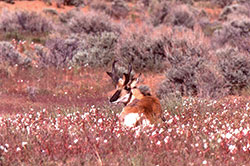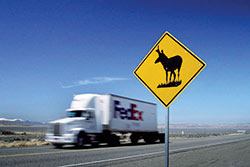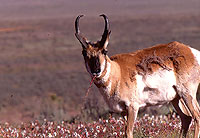 Interspersed between the spectacular Utah canyonlands and high plateaus are vast tracts of sagebrush and dry grasslands. These areas, broken only by small ridges or thirsty washes, form a stark, often bleak, contrast to the region’s colorful redrock canyons and snow-capped mountain peaks.
Interspersed between the spectacular Utah canyonlands and high plateaus are vast tracts of sagebrush and dry grasslands. These areas, broken only by small ridges or thirsty washes, form a stark, often bleak, contrast to the region’s colorful redrock canyons and snow-capped mountain peaks.
North of Arches National Park, Interstate 70 slices through two such landscapes known as the Cisco and Green River deserts. Though travelers tend to speed through this region as quickly as possible, little do they realize what they are missing. Certainly, it’s not the nightlife of Thompson Springs, Crescent Junction, or the living ghost town of Cisco, a skeleton of its former self. Even the muted colors of the geologic layers which dominate this area, made up of ancient mudflats and shallow brackish seas, doesn’t hold one’s attention very long.
But what these areas may lack in geologic beauty is more than made up by the richness of wildlife that inhabits these landscapes.
 Chief amongst the inhabitants living in these regions are white-tailed prairie dogs, desert cottontails, black-tailed jackrabbits, and an assortment of small rodents including kangaroo rats, bushy-tailed woodrats, and various species of mice. These creatures feed on grasses, seeds, and woody vegetation in this near-waterless region. In turn, these small mammals attract predators such as bobcats, coyotes, kit foxes, and the occasional wandering bear or cougar. Aerial specialists such as golden eagles, ferruginous and red-tailed hawks, burrowing owls, and great horned owls hunt for prey from above. It’s an American Serengeti on a vastly different scale.
Chief amongst the inhabitants living in these regions are white-tailed prairie dogs, desert cottontails, black-tailed jackrabbits, and an assortment of small rodents including kangaroo rats, bushy-tailed woodrats, and various species of mice. These creatures feed on grasses, seeds, and woody vegetation in this near-waterless region. In turn, these small mammals attract predators such as bobcats, coyotes, kit foxes, and the occasional wandering bear or cougar. Aerial specialists such as golden eagles, ferruginous and red-tailed hawks, burrowing owls, and great horned owls hunt for prey from above. It’s an American Serengeti on a vastly different scale.
Of all the creatures that exist out in this landscape, the American pronghorn, Antilocapra americana, stands out above the sagebrush. Though often referred to as an “antelope” - even in the famous song Home on the Range, “Where the deer and the antelope play…”, these creatures are the sole surviving member of an ancient lineage of even-toed ungulates (Antilocapra) which existed in North America. The closest living relative of the American pronghorn today are giraffes.
Adult pronghorn, named for the two “prongs” on their horns, are pale brown to reddish-brown in color with a white belly and a unique black and white facial pattern. Their white rump is especially visible when the animals are alert to danger. The white hairs enlarge and create a visual warning sign to other members of their herd. And if danger is near, the pronghorn uses their incredible speed to run away from predators. As the fastest land animal in North America, these hoofed animals can sprint up to 60 miles per hour or maintain a 30-mph pace for several miles at a clip. In addition to their speed, pronghorns have excellent eyesight to spot predators.
 In spring, females bear young spotted fawns, sometimes as twins. Though able to walk soon after birth, the young cannot outrun predators as newborns. Instead, they rely on camouflage and lying motionless in shrubby areas to avoid predators such as coyotes, bobcats, and golden eagles. The young develop quickly and travel with their mothers in small herds foraging on grasses, sagebrush, wildflowers, and other woody plants. In order to obtain the maximum amount of nutrients and moisture from this plant material, pronghorn regurgitate this material and rechew the cud into smaller pieces.
In spring, females bear young spotted fawns, sometimes as twins. Though able to walk soon after birth, the young cannot outrun predators as newborns. Instead, they rely on camouflage and lying motionless in shrubby areas to avoid predators such as coyotes, bobcats, and golden eagles. The young develop quickly and travel with their mothers in small herds foraging on grasses, sagebrush, wildflowers, and other woody plants. In order to obtain the maximum amount of nutrients and moisture from this plant material, pronghorn regurgitate this material and rechew the cud into smaller pieces.
Once abundant across Western North America, pronghorn populations declined due to hunting, encroachment by settlers, and habitat conversion to agriculture. The declines were so severe in certain regions that early 20th century biologists feared the animals would become extinct. Fortunately, protections were enacted to maintain these magnificent creatures to continue at home on the range.